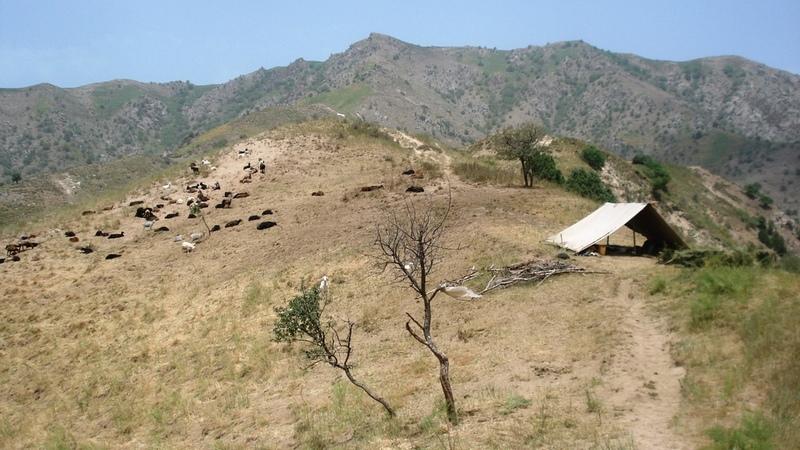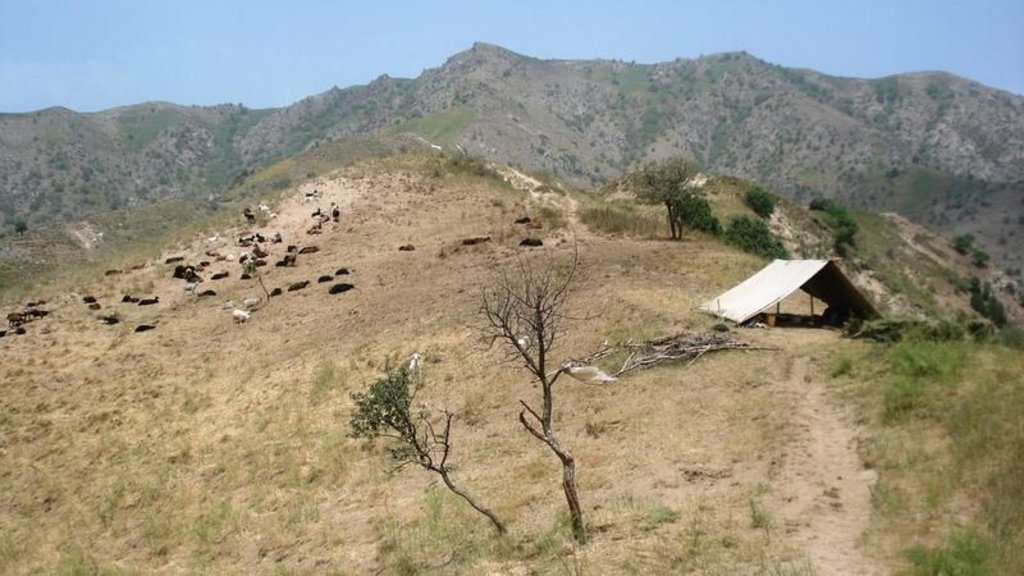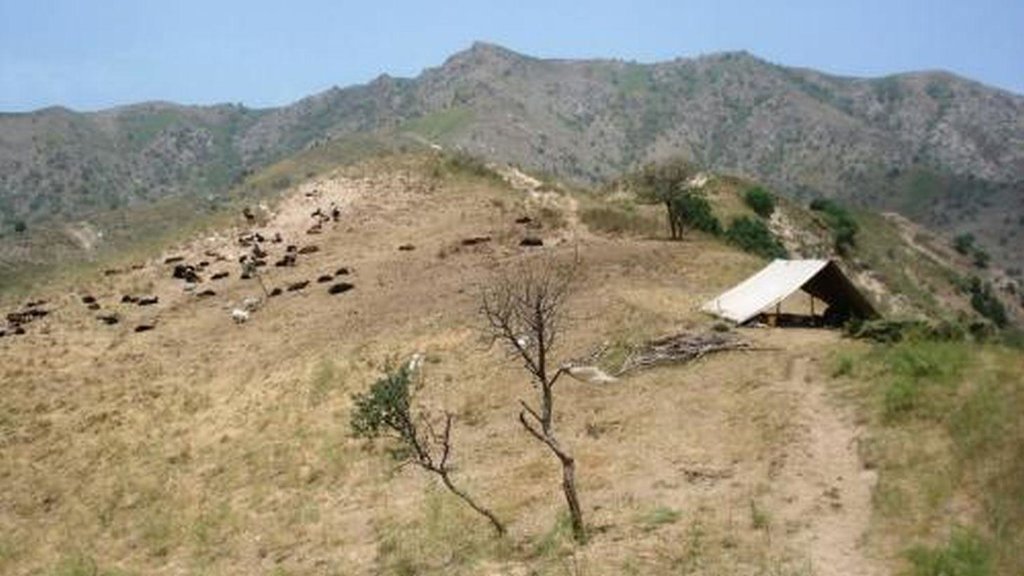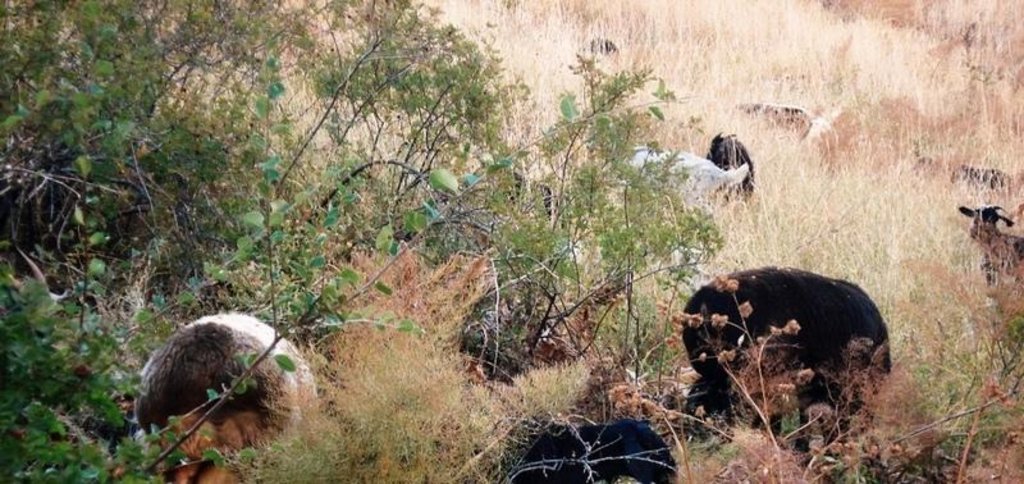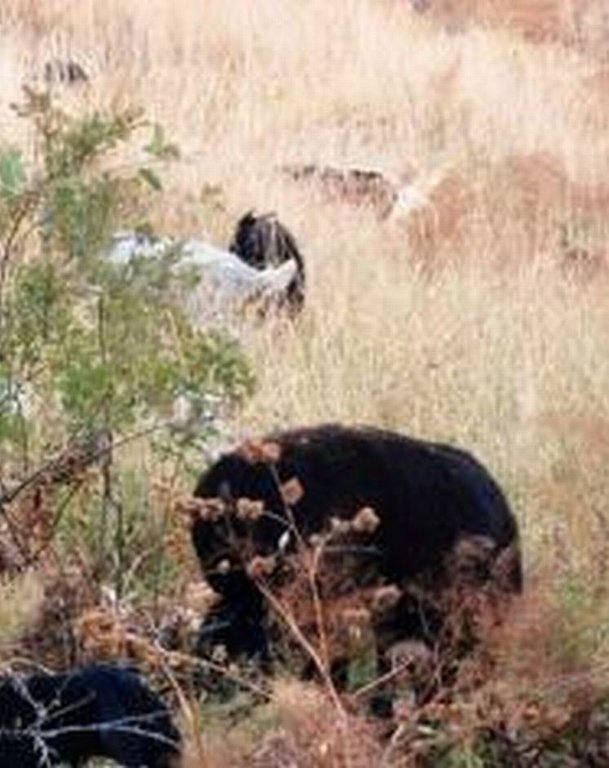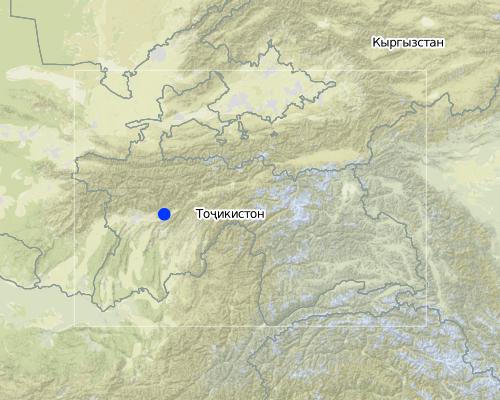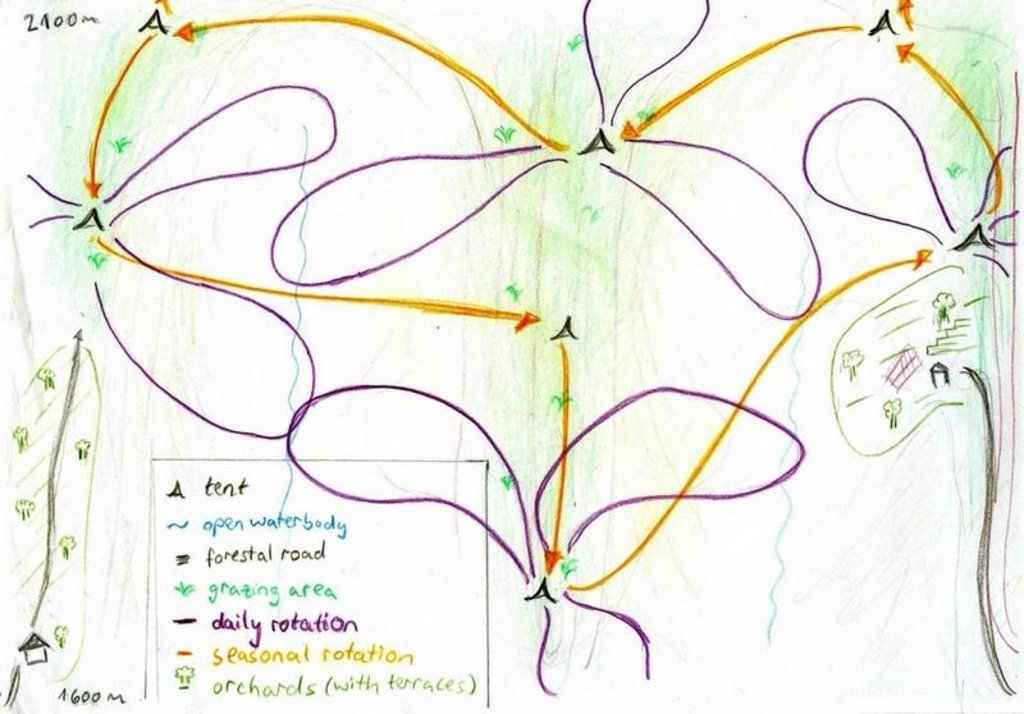Daily and seasonal rotation on grassland [Tajiquistão]
- Criação:
- Atualização:
- Compilador/a: Christian Wirz
- Editor: –
- Revisor: David Streiff
Dajmardei Kaspi (professional herder)
technologies_1407 - Tajiquistão
Veja as seções
Expandir tudo Recolher tudo1. Informação geral
1.2 Detalhes do contato das pessoas capacitadas e instituições envolvidas na avaliação e documentação da tecnologia
Nome da(s) instituição(ões) que facilitou(ram) a documentação/ avaliação da Tecnologia (se relevante)
CDE Centre for Development and Environment (CDE Centre for Development and Environment) - SuíçaNome da(s) instituição(ões) que facilitou(ram) a documentação/ avaliação da Tecnologia (se relevante)
NCCR North-South (NCCR North-South) - Quirguizistão1.3 Condições em relação ao uso da informação documentada através de WOCAT
Quando os dados foram compilados (no campo)?
15/08/2008
O/a compilador/a e a(s) pessoa(s) capacitada(s) aceitam as condições relativas ao uso de dados documentados através da WOCAT:
Sim
1.5 Referência ao(s) questionário(s) sobre as abordagens da GST
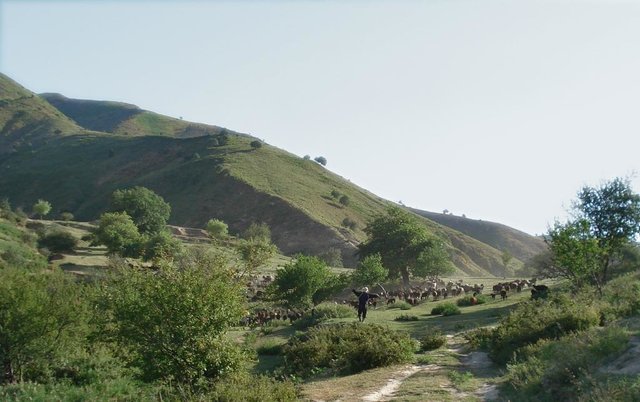
Seminomadic individual herding [Tajiquistão]
Pasture management by a single herder, assisted either by an employee or by his own grandchildren, in collaboration with the habitants of the nearby village Karsang.
- Compilador/a: Christian Wirz
2. Descrição da tecnologia de GST
2.1 Descrição curta da tecnologia
Definição da tecnologia:
Extensive grazing of sheep and goats by the means of a precise rotational scheme
2.2 Descrição detalhada da tecnologia
Descrição:
Half-year herding with 500 sheep, goats and cows (very few), with 7-8 different locations of the herder's tent. The herder visits each place twice to thrice per grazing season and stays in one place for one week to maximally one month (during the Ramadan period, due to limited forces). The area is grazed from the higher zone (around 2000m) to the lower zone (around 1600m) twice per season, in a sort of circle. Every day the herder starts in another direction from his tent and leads the animals to the pastures, once in the morning and once in the evening. He passes a stream once (autumn) to twice (summer) a day.
Purpose of the Technology: The grass should not get dusty and dirty, explaining why the herder daily changes the pastures, only revisiting the same places every two to three days.
Establishment / maintenance activities and inputs: After accompanying his father as a child and a kind of an apprenticeship (of one year) later on, M. is considered by the villagers as a good herder and they give him their animals for herding. But M. applies for land on the forest department only after working as a guardian and as a tractor driver for 20 years. For the herding profession observing the animals precisely is necessary, in order not to lose any of them. And the maintenance of the pastures is guaranteed by the strict rotational scheme.
Natural / human environment: The pasture-area is in a generally well-conserved state. Moderate to high values of fractional vegetation cover can be observed and only few signs of recent erosion processes (through water) are visible. The area is characterised by steep slopes where still signs of past tree-planting during the USSR period are visible by some trees, many little platforms made for tree-planting and a few terraced areas. Eventhough, many trees have been grazed and do not stand anymore. Besides steep areas there are small, quite flat areas (where the herder installs his tents), that used to be cultivated (wheat) till 1966. These areas generally have low cover-values and signs of rill-erosion, which the herder attributes to the past tilling activity. However, it might also be the trampling and sitting of the animals (staying near the herder's tent at noon-time and during the night) causing this erosion. Nutrient management is provided for by the dung of the animals which is not collected, contrarily to the pastures near the villages.
2.3 Fotos da tecnologia
2.5 País/região/locais onde a tecnologia foi aplicada e que estão cobertos nesta avaliação
País:
Tajiquistão
Região/Estado/Província:
Region of Republican Subordination
Especificação adicional de localização:
Faizabad
Map
×2.6 Data da implementação
Caso o ano exato seja desconhecido, indique a data aproximada:
- mais de 50 anos atrás (tradicional)
2.7 Introdução da tecnologia
Especifique como a tecnologia foi introduzida:
- Como parte do sistema tradicional (>50 anos)
Comentários (tipos de projeto, etc.):
There are traditional herding peoples like Kuagwates, Kaleks, Lakais, Duramanes, Kurtshaliks), not Tajiks. These often move around with their whole families.
3. Classificação da tecnologia de GST
3.2 Tipo(s) atualizado(s) de uso da terra onde a tecnologia foi aplicada

Pastagem
Pastagem extensiva:
- Seminomadismo/pastoralismo
Principais espécies animais e produtos:
sheep* / goats* / cows
* if wildlife is major part of the grazing system
Comentários:
Major land use problems (compiler’s opinion): The trampling of the animals near the tent, the feeding on young trees and the daily passage of the herd of a limited number of streams (eutrophication).
Major land use problems (land users’ perception): No major land use problems due to good management. Only the first rain that cannot be absorbed by the dry soils is a problem.
Semi-nomadism / pastoralism: sheep* / goats* / cows
Future (final) land use (after implementation of SLM Technology): Grazing land: Ge: Extensive grazing land
Caso o uso da terra tenha mudado devido a implementação da tecnologia, indique seu uso anterior à implementação da tecnologia:
Forests / woodlands: Fp: Plantations, afforestations
3.3 Mais informações sobre o uso da terra
Abastecimento de água para a terra na qual a tecnologia é aplicada:
- Precipitação natural
Número de estações de cultivo por ano:
- 1
Especifique:
Longest growing period in days: 270Longest growing period from month to month: Oct - Jun
Densidade animal (se relevante):
< 1 LU/km2
3.4 Grupo de GST ao qual pertence a tecnologia
- Gestão de pastoralismo e pastagem
3.5 Difusão da tecnologia
Comentários:
Total area covered by the SLM Technology is 3 km2.
The half of the herded area is rented by another person from the village, who gives his animals to the herder. Apart from the interviewed herder there are varying numbers of other semi-nomadic herders with similar management practices, some of them from other regions.
3.6 Medidas de GST contendo a tecnologia

Medidas de gestão
- M1: Mudança no tipo de uso da terra
- M4: Principal mudança no calendário de atividades
Comentários:
Main measures: management measures
3.7 Principais tipos de degradação da terra abordados pela tecnologia

Deteriorização química do solo
- Cn: declínio de fertilidade e teor reduzido de matéria orgânica (não causado pela erosão)

Degradação biológica
- Bs: Qualidade e composição de espécies/declínio de diversidade
Comentários:
Secondary types of degradation addressed: Cn: fertility decline and reduced organic matter content, Bs: quality and species composition /diversity decline
Main causes of degradation: overgrazing (Causing Pc, Bc, Wt), droughts (Causing Pk, Pc, Ha), degradation of near-village pastures (The pressure on more distant areas increases)
Secondary causes of degradation: soil management (passed tilling with impact on Wt), floods (Intensive rains causing Wt), land tenure (Little interest in tree-planting if land can only be rented annually)
3.8 Redução, prevenção ou recuperação da degradação do solo
Especifique o objetivo da tecnologia em relação a degradação da terra:
- Prevenir degradação do solo
Comentários:
Main goals: prevention of land degradation
4. Especificações técnicas, implementação de atividades, entradas e custos
4.1 Desenho técnico da tecnologia
4.2 Especificações técnicas/ explicações do desenho técnico
Daily and seasonal rotation.
Location: Above Karsang. Faizabad / Tajikistan
Date: 05.08.09
Technical knowledge required for field staff / advisors: low (Obeying to what the herder says)
Technical knowledge required for land users: moderate (It is necessary to know how to lead animals, more than in the case of the common pasture-area)
Main technical functions: control of dispersed runoff: retain / trap, increase of biomass (quantity)
Secondary technical functions: improvement of ground cover, control of fires, palatable fodder
Change of land use type: From afforestation and limited use as cropland to extensive grazing
Major change in timing of activities: Introduction of a strict rotational grazing scheme
4.3 Informação geral em relação ao cálculo de entradas e custos
Especifique a moeda utilizada para os cálculos de custo:
- Dólares norte-americanos
Indique a média salarial da mão-de-obra contratada por dia:
6.10
4.4 Atividades de implantação
| Atividade | Tipo de medida | Periodicidade | |
|---|---|---|---|
| 1. | Buying a herd | Gestão | constantly investing |
4.5 Custos e entradas necessárias para a implantação
| Especifique a entrada | Unidade | Quantidade | Custos por unidade | Custos totais por entrada | % dos custos arcados pelos usuários da terra | |
|---|---|---|---|---|---|---|
| Outros | Buying a herd | animals | 50,0 | 87,7 | 4385,0 | 100,0 |
| Custos totais para a implantação da tecnologia | 4385,0 | |||||
Comentários:
Duration of establishment phase: 12 month(s)
4.6 Atividades recorrentes/manutenção
| Atividade | Tipo de medida | Periodicidade/frequência | |
|---|---|---|---|
| 1. | Rent fee for land of forest department | Gestão | once per year |
| 2. | Salary of an assistant herder (normally, but not in 2008) | Gestão | at the end of the season |
| 3. | compensation for dead animals | Gestão | at the end of the season |
| 4. | Animal medecine | Gestão | if necessary |
| 5. | Salt | Gestão | daily |
4.7 Custos e entradas necessárias pata a manutenção/atividades recorrentes (por ano)
| Especifique a entrada | Unidade | Quantidade | Custos por unidade | Custos totais por entrada | % dos custos arcados pelos usuários da terra | |
|---|---|---|---|---|---|---|
| Mão-de-obra | Salary of an assistant herder | Days | 120,0 | 6,1 | 732,0 | 100,0 |
| Outros | Rent fee for land of forest department | 300ha/d | 180,0 | 0,4888888 | 88,0 | 100,0 |
| Outros | Compensation for dead animals | animals | 2,0 | 44,0 | 88,0 | 100,0 |
| Outros | Animal medecine | per year | 1,0 | 88,0 | 88,0 | 100,0 |
| Outros | Salt | kg | 1000,0 | 0,08 | 80,0 | 100,0 |
| Custos totais para a manutenção da tecnologia | 1076,0 | |||||
Comentários:
The costs are valid for a herd of 250 animals kept by the herder alone for six months and additional 250 animals kept during summer holidays with the help of additional workforce. The salary indicated was not valid for 2008 (the grandsons helped the herder), but for years when M. hires external workforce. For all costs, including 50 own animal, prices in 2008 are taken.
4.8 Fatores mais importantes que afetam os custos
Descreva os fatores mais determinantes que afetam os custos:
Buying an own herd and looking for the animals are the most expensive factors, expecially if there are sick or dead animals.
5. Ambiente natural e humano
5.1 Clima
Precipitação pluviométrica anual
- <250 mm
- 251-500 mm
- 501-750 mm
- 751-1.000 mm
- 1.001-1.500 mm
- 1.501-2.000 mm
- 2.001-3.000 mm
- 3.001-4.000 mm
- > 4.000 mm
Especificações/comentários sobre a pluviosidade:
Mainly in spring and also in autumn, with a trend to decrease
Zona agroclimática
- Semiárido
Thermal climate class: temperate
5.2 Topografia
Declividade média:
- Plano (0-2%)
- Suave ondulado (3-5%)
- Ondulado (6-10%)
- Moderadamente ondulado (11-15%)
- Forte ondulado (16-30%)
- Montanhoso (31-60%)
- Escarpado (>60%)
Formas de relevo:
- Planalto/planície
- Cumes
- Encosta de serra
- Encosta de morro
- Sopés
- Fundos de vale
Zona de altitude:
- 0-100 m s.n.m.
- 101-500 m s.n.m.
- 501-1.000 m s.n.m.
- 1.001-1.500 m s.n.m.
- 1.501-2.000 m s.n.m.
- 2.001-2.500 m s.n.m.
- 2.501-3.000 m s.n.m.
- 3.001-4.000 m s.n.m.
- > 4.000 m s.n.m.
Comentários e outras especificações sobre a topografia:
Altitudinal zone: Pasture area around 1600 to 2000 m
Landforms ridges: Small, not so steep areas where the tent of the herder is installed
Landforms mountain slopes: The pasture area is generally very steep
Slopes on average steep (31-60%): The areas mostly frequented are steep
Slopes on average very steep (>60%): The areas dominating spatially are very steep
Slopes on average hilly (16-30%): Ridge areas
5.3 Solos
Profundidade do solo em média:
- Muito raso (0-20 cm)
- Raso (21-50 cm)
- Moderadamente profundo (51-80 cm)
- Profundo (81-120 cm)
- Muito profundo (>120 cm)
Textura do solo (solo superficial):
- Médio (limoso, siltoso)
Matéria orgânica do solo superficial:
- Baixo (<1%)
Caso disponível anexe a descrição completa do solo ou especifique as informações disponíveis, p. ex. tipo de solo, PH/acidez do solo, nitrogênio, capacidade de troca catiônica, salinidade, etc.
Soil depth on average shallow: Most grassy areas
Soil fertility is low: on the surface of 300 ha the summed up dung of 500 sheep and goats cannot compensate for the loss of topsoil by wind and water
Soil drainage / infiltration is good: Generally high infiltration capacity enhanced by high vegetation cover values
Soil water storage capacity medium (dominatig the area): Loamy soils and high cover values, but generally little trees and dried vegetation in August
Soil water storage capacity can also be good: Near the streams higher water retention, according to herder
5.4 Disponibilidade e qualidade de água
Disponibilidade de água de superfície:
Precário/nenhum
Qualidade da água (não tratada):
apenas para uso agrícola (irrigação)
Comentários e outras especificações sobre a qualidade e a quantidade da água:
Water quality (untreated): Locals drink the water, but are affected by diarrhoea
5.5 Biodiversidade
Diversidade de espécies:
- Alto
Comentários e outras especificações sobre biodiversidade:
Diversity higher than near the villages, but not comparable with biodiversity hot-spots
5.6 Características dos usuários da terra que utilizam a tecnologia
Sedentário ou nômade:
- Semi-nômade
Rendimento não agrícola:
- Menos de 10% de toda renda
Nível relativo de riqueza:
- Rico
Indivíduos ou grupos:
- Indivíduo/unidade familiar
Gênero:
- Homens
Indique outras características relevantes dos usuários da terra:
Land users applying the Technology are mainly common / average land users
Difference in the involvement of women and men: Herding is considered as a male profession, inherited from father to son. In nomadic peoples the whole families are mobile and women are responsible for domestic work.
Population density: < 10 persons/km2
Annual population growth: 1% - 2%
100% of the land users are rich (100).
Off-farm income specification: The herder claims to nourish himself and his wife with the income from herding. But, once he willl not be able to work as a herder anymore, he might depend on off-farm income from his children (remittances)
5.7 Média da área de terra própria ou arrendada por usuários da terra que utilizam a tecnologia
- < 0,5 ha
- 0,5-1 ha
- 1-2 ha
- 2-5 ha
- 5-15 ha
- 15-50 ha
- 50-100 ha
- 100-500 ha
- 500-1.000 ha
- 1.000-10.000 ha
- > 10.000 ha
É considerado pequena, média ou grande escala (referente ao contexto local)?
- Pequena escala
Comentários:
3 households can afford to pay the services of the professional herder (clearly a minority of village population)
5.8 Propriedade de terra, direitos de uso da terra e de uso da água
Propriedade da terra:
- Estado
Direitos do uso da terra:
- Arrendado
Direitos do uso da água:
- Comunitário (organizado)
5.9 Acesso a serviços e infraestrutura
Saúde:
- Pobre
- Moderado
- Bom
Educação:
- Pobre
- Moderado
- Bom
Assistência técnica:
- Pobre
- Moderado
- Bom
Emprego (p. ex. não agrícola):
- Pobre
- Moderado
- Bom
Mercados:
- Pobre
- Moderado
- Bom
Energia:
- Pobre
- Moderado
- Bom
Vias e transporte:
- Pobre
- Moderado
- Bom
Água potável e saneamento:
- Pobre
- Moderado
- Bom
Serviços financeiros:
- Pobre
- Moderado
- Bom
6. Impactos e declarações finais
6.1 Impactos no local mostrados pela tecnologia
Impactos socioeconômicos
Produção
Produção de forragens
Comentários/especificar:
Higher vegetation cover and biomass values than for village-pastures
Qualidade da forragem
Comentários/especificar:
Much less impalatable species' frequency
Produção animal
Comentários/especificar:
The animals get much fatter and are sold for around 50% higher price than animals from common pastures
Produção de madeira
Comentários/especificar:
The herder says that tree density has decreased, due to livestock but also to chopping. Additionally chopping of living trees is generally forbidden (since the 1960s, when the forest department was created as a new land use type), not making possible the
Área de produção
Comentários/especificar:
The use of the land for fruit production is not possible with animals grazing, but this was also the case before, as to the herder's opinion
Disponibilidade e qualidade de água
Qualidade da água para irrigação
Comentários/especificar:
Due to reduced stocking rates in comparison with village-pastures (and the soviet times), better water quality
Impactos socioculturais
Segurança alimentar/auto-suficiência
Estado de saúde
Oportunidades de lazer
Livelihoods and human well-being
Impactos ecológicos
Ciclo hídrico/escoamento
Escoamento superficial
Comentários/especificar:
Better control of runoff, but steeper land
Drenagem de excesso de água
Solo
Cobertura do solo
Quantidade anterior à GST:
40%
Quantidade posterior à GST:
80%
Comentários/especificar:
Higher cover than on village-pastures
Biodiversidade: vegetação, animais
Diversidade vegetal
Quantidade anterior à GST:
36 species
Quantidade posterior à GST:
47 species
Comentários/especificar:
More plant systematical diversity
Clima e redução de riscos de desastre
Risco de incêndio
Comentários/especificar:
According to forest department the area above Karsang, due to ist trees, is more prone to fires than other areas
6.3 Exposição e sensibilidade da tecnologia às mudanças climáticas graduais e extremos/desastres relacionados ao clima (conforme o ponto de vista dos usuários da terra)
Extremos (desastres) relacionados ao clima
Desastres climatológicos
| Como a tecnologia lida com isso? | |
|---|---|
| Seca | não bem |
Outras consequências relacionadas ao clima
Outras consequências relacionadas ao clima
| Como a tecnologia lida com isso? | |
|---|---|
| Período de crescimento reduzido | bem |
Comentários:
A possible adaption to dryer conditions would be smaller herds.
6.4 Análise do custo-benefício
Como os benefícios se comparam aos custos de implantação (do ponto de vista dos usuários da terra)?
Retornos a curto prazo:
neutro/balanceado
Retornos a longo prazo:
muito positivo
Como os benefícios se comparam aos custos recorrentes/de manutenção(do ponto de vista dos usuários da terra)?
Retornos a curto prazo:
levemente positivo
Retornos a longo prazo:
positivo
Comentários:
4 Years ago a herd of 400 animals had to be sold due to disease. Since then M was able to rebuild a herd of 500 animals. On a short term investing into animals is expensive but pays quickly. The maintenance costs are finally decisive, but quite constant.
6.5 Adoção da tecnologia
- casos isolados/experimental
Se disponível, determine a quantidade (número de unidades familiares e/ou área abordada):
1 Household
Entre todos aqueles que adotaram a tecnologia, quantos adotaram espontaneamente, ou seja, sem receber nenhum incentivo material/pagamentos?
- 0-10%
Comentários:
100% of land user families have adopted the Technology with external material support
1 land user families have adopted the Technology with external material support
Comments on acceptance with external material support: The herder gets paid by the villagers for taking care of their animals
There is no trend towards spontaneous adoption of the Technology
Comments on adoption trend: According to the herder, young people do not (want to) bear the very physical work.
6.7 Pontos fortes/vantagens/oportunidades da tecnologia
| Pontos fortes/vantagens/oportunidades na visão do usuário da terra |
|---|
|
Grazing stabilises the soils and is thus a prevention against gully erosion in areas with low cover (former cropland). Animals have the same effect as the terraces built years ago. How can they be sustained / enhanced? Grazing activity should continue, once M. is too old for working. |
| The animals provide for soil fertility by their dung, instead of the fertilisers used in Soviet times. This positively influences the share of palatable plants and cover in general and, by this, soil moisture. |
| The area on the forest department is a good alternative to the much too small pasture-area near the village |
| Pontos fortes/vantagens/oportunidades na visão do/a compilador/a ou de outra pessoa capacitada |
|---|
|
Form of land use making it possible to take some pressure from the common pastures without great damages. How can they be sustained / enhanced? It needs to be assured that also poorer families, who depend even more on livestock breeding than richer ones, can give their animals to M. or other professional herders. This could be realised by engaging herder assistants from poor families |
|
The rotational scheme is much more elaborated than in the case of the villages' pastures, which can be explained by more land available How can they be sustained / enhanced? Land users like M. should be addressed by forest administration to elaborate legal forms of herding with little damages on natural resources on this land. This will probably require land reforms. |
6.8 Pontos fracos, desvantagens/riscos da tecnologia e formas de superá-los
| Pontos fracos/desvantagens/riscos na visão do usuário da terra | Como eles podem ser superados? |
|---|---|
| Tree planting is not possible as long as the area is used for grazing. | By giving people land for longer periods (than one year) and with more freedoms in its use, people would gain interest in diversifying use: They would split up "their" land into haymaking, orchard and pasture areas. |
| Pontos fracos/vantagens/riscos na visão do/a compilador/a ou de outra pessoa capacitada | Como eles podem ser superados? |
|---|---|
| The main problem of this form of grazing is that it doesn't allow the regrowth of trees. | Changing the areas use for grazing, respectively haymaking, every few years. |
| Cover is markedly reduced around the places where tents are installed. | By changing the camping place (but: limited flat areas!) or not keeping the animals in the same place at noon time and during night time, these areas might recover. |
Links e módulos
Expandir tudo Recolher tudoLinks

Seminomadic individual herding [Tajiquistão]
Pasture management by a single herder, assisted either by an employee or by his own grandchildren, in collaboration with the habitants of the nearby village Karsang.
- Compilador/a: Christian Wirz
Módulos
Não há módulos


